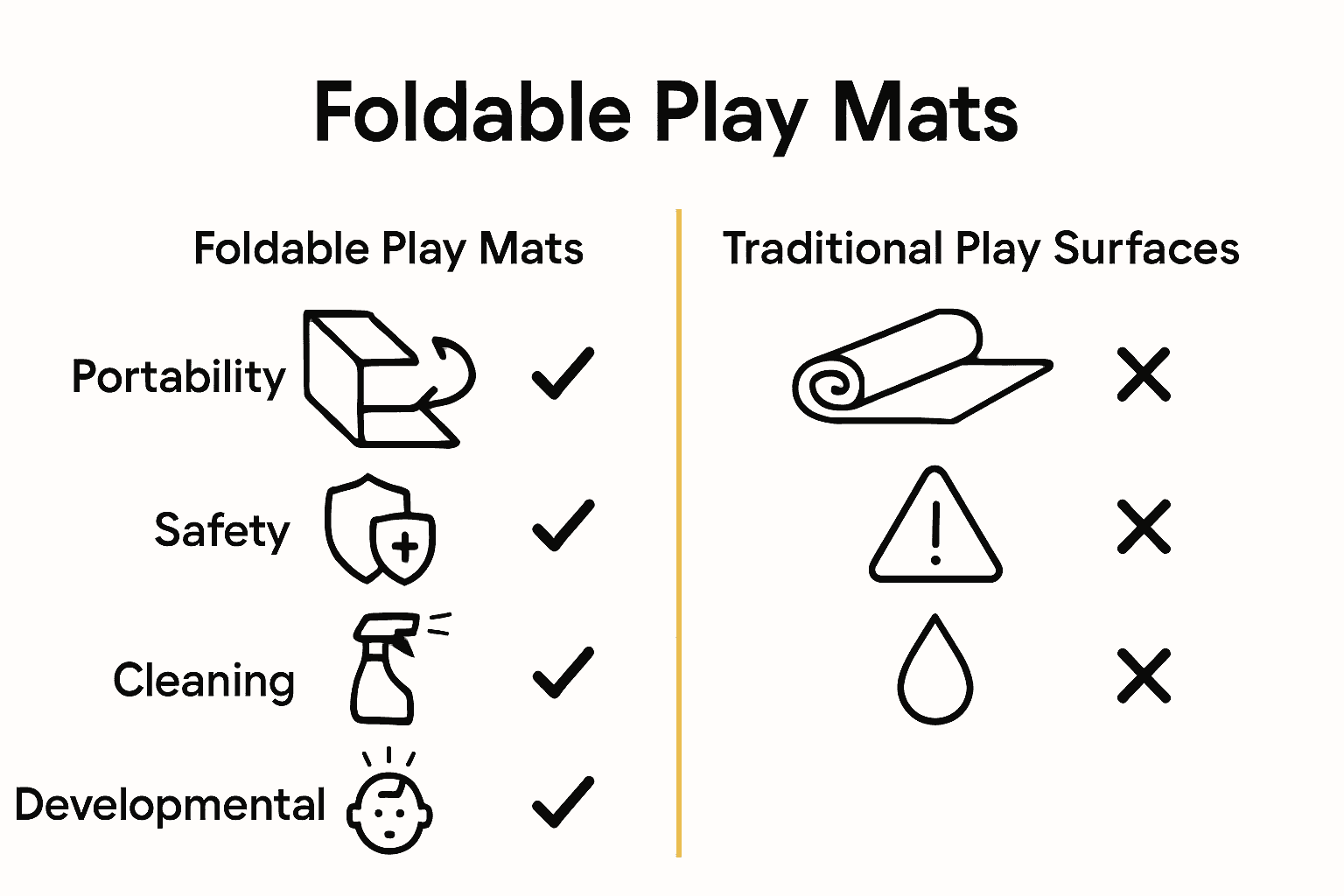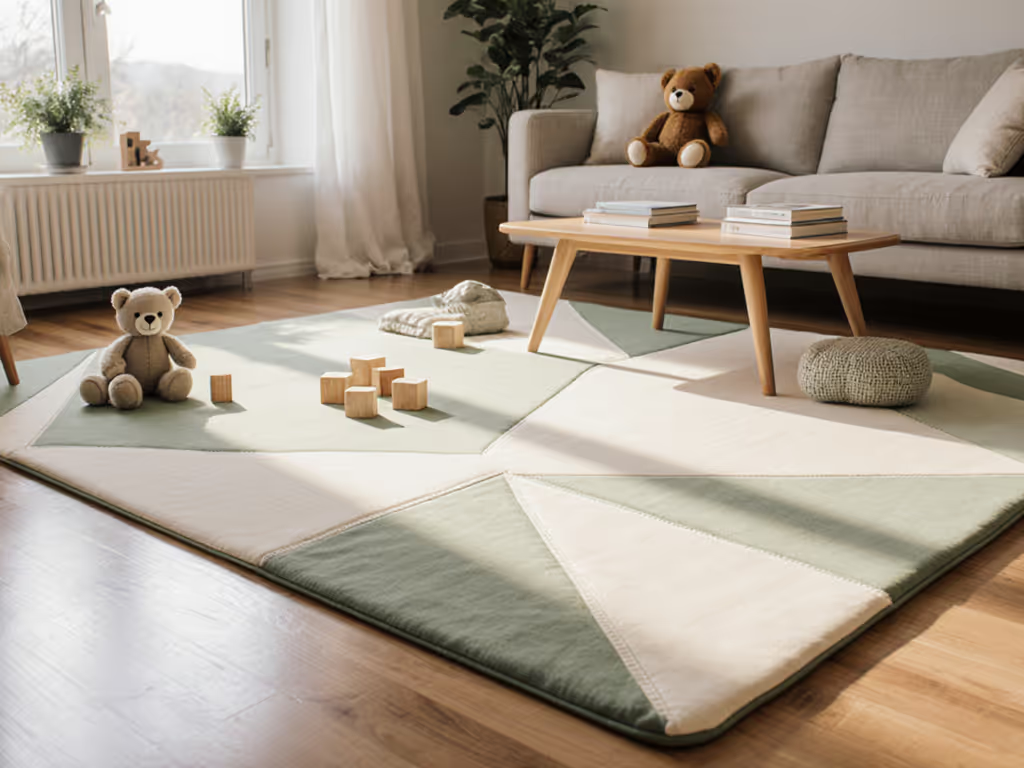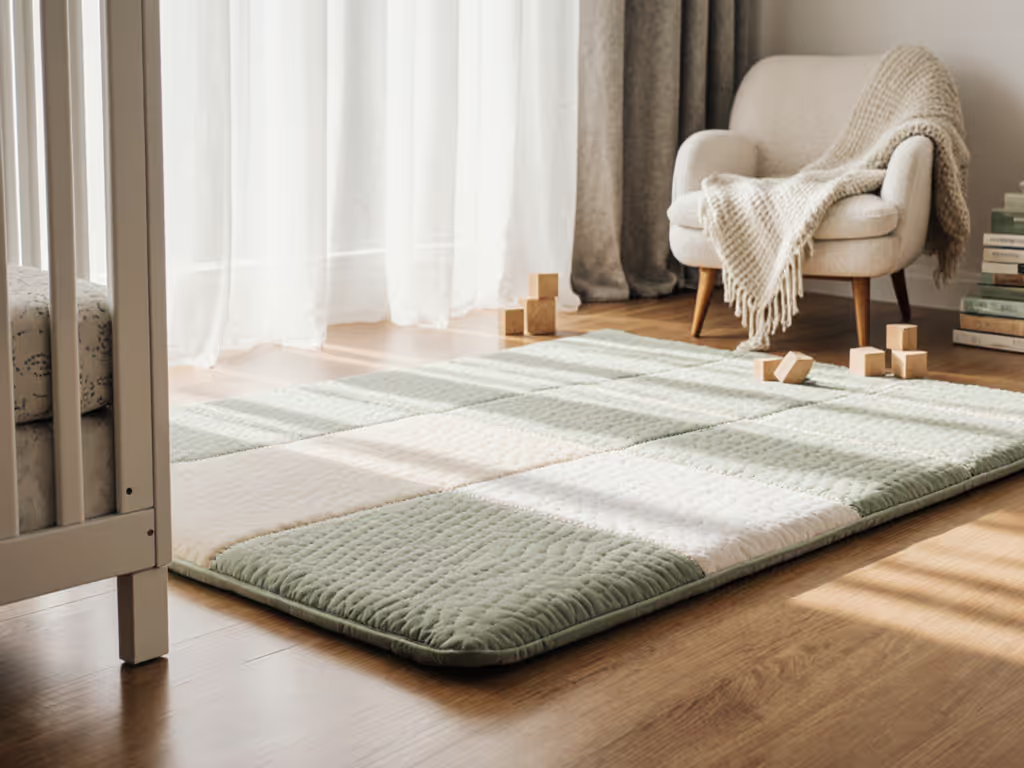
What Is a Foldable Play Mat? Complete Guide

Most parents quickly discover that soft, secure play spaces make a world of difference for active babies and toddlers. With over 80 percent of households seeking safer alternatives to traditional rugs, the demand for foldable play mats keeps rising. These mats do more than cushion little falls—they create flexible, engaging areas that support every stage of early development. Whether space is tight or versatility is key, understanding the advantages of foldable play mats helps parents choose what truly fits their growing family’s needs.
Key Takeaways
| Point | Details |
|---|---|
| Versatile Design | Foldable play mats provide a portable, safe, and cushioned surface for infant and toddler play, suitable for various environments. |
| Developmental Benefits | These mats facilitate physical, cognitive, and sensory development by offering a secure space for infants to explore and learn movement skills. |
| Material Safety | Parents should prioritize mats made from non-toxic, hypoallergenic materials and seek third-party certifications to ensure safety for their children. |
| Maintenance and Storage | Proper cleaning and storage methods are essential to prolong the life and hygiene of the play mats, including regular inspections for wear and damage. |
Defining a Foldable Play Mat and Core Uses
A foldable play mat is a versatile, portable surface designed specifically for infant and toddler play environments. Unlike traditional floor mats, these innovative products offer parents a compact, easily storable solution that transforms any space into a safe and stimulating play area. Imagine having a cushioned, protective surface you can quickly unfold in your living room, bedroom, or even during outdoor activities - that's the magic of a foldable play mat.
The core uses of a foldable play mat extend far beyond simple floor covering. These mats serve multiple critical developmental purposes for young children.
 Primary functions include creating a safe exploration zone for crawling infants, providing cushioned protection during playtime, supporting motor skill development, and offering sensory stimulation through integrated design features. Babies can roll, stretch, practice tummy time, and learn fundamental movement skills without parents worrying about hard floor surfaces or potential injuries.
Primary functions include creating a safe exploration zone for crawling infants, providing cushioned protection during playtime, supporting motor skill development, and offering sensory stimulation through integrated design features. Babies can roll, stretch, practice tummy time, and learn fundamental movement skills without parents worrying about hard floor surfaces or potential injuries.
Designed with modern parenting challenges in mind, foldable play mats typically feature key characteristics such as:
- Soft, padded surfaces for infant comfort
- Lightweight and portable construction
- Easy fold-and-store mechanisms
- Water-resistant or washable materials
- Non-toxic, baby-safe components
- Optional integrated play elements like textures or hanging toys
While each foldable play mat might have unique design elements, their fundamental purpose remains consistent: creating a safe, engaging environment that supports infant development. Whether you're a first-time parent looking for a flexible play solution or a caregiver seeking a practical infant accessory, these mats represent an intelligent investment in your child's early learning and exploration journey.
Types of Foldable Play Mats Explained
Foldable play mats come in a diverse range of materials, designs, and functionalities, each tailored to meet different parental needs and infant developmental stages. Material composition plays a crucial role in determining the mat's performance, safety, and overall utility. From eco-friendly organic cotton options to high-tech synthetic materials, parents have an impressive array of choices to suit their specific requirements.
One primary classification of foldable play mats centers around their primary material construction. XPE (Cross-linked Polyethylene) foam mats represent a popular modern choice, offering exceptional characteristics like non-toxicity, soft texture, and suitability for both indoor and outdoor environments. These mats provide superior cushioning and impact absorption, making them ideal for infants learning to move and explore. Another prevalent category includes organic cotton mats, which appeal to environmentally conscious parents seeking natural, breathable surfaces with minimal chemical processing.
The versatility of foldable play mats extends beyond material selection. Parents can choose from several specialized types:
- Reversible mats featuring different designs or textures on each side
- Puzzle-style mats with interlocking pieces for customizable play areas
- Activity mats with integrated sensory elements like hanging toys
- Waterproof mats designed for outdoor use or messy play scenarios
- Themed mats featuring educational graphics or playful illustrations
Beyond material and design considerations, modern foldable play mats increasingly incorporate advanced features that enhance their functionality. Some cutting-edge options include temperature-regulating surfaces, antimicrobial treatments, and ergonomic designs that support proper infant posture during playtime.
The key is finding a mat that not only provides a safe play environment but also stimulates your child's sensory and motor skill development while offering practical benefits like easy cleaning and compact storage.
Key Materials, Safety, and Certification Standards
Parents selecting a foldable play mat must navigate a complex landscape of material safety and potential health considerations. Different materials used in play mat construction can significantly impact infant health, with some synthetic options raising potential concerns about chemical exposure. The primary materials found in play mats include EVA (Ethylene Vinyl Acetate), PVC (Polyvinyl Chloride), polyurethane, and organic cotton - each presenting unique safety profiles and potential risks.
The safety of play mat materials goes beyond simple composition. Certification standards play a critical role in ensuring infant protection. While commercial soft play equipment often follows strict guidelines like BS EN 1176 and BS EN 1177, consumer play mats require careful individual assessment. Parents should prioritize materials that are:
- Free from harmful chemicals like BPA and phthalates
- Non-toxic and hypoallergenic
- Low in volatile organic compounds (VOCs)
- Resistant to bacterial and fungal growth
- Easily cleanable and moisture-resistant
Organic cotton and XPE (Cross-linked Polyethylene) foam emerge as safer alternatives in the play mat market. These materials offer superior safety credentials, with XPE foam providing exceptional cushioning while maintaining non-toxic properties. Organic cotton mats represent an environmentally conscious choice, minimizing chemical processing and potential allergen exposure. When evaluating play mat safety, parents should look for third-party certifications, conduct thorough material research, and prioritize transparent manufacturing practices that demonstrate commitment to infant health and environmental responsibility.
Ultimately, selecting a safe play mat requires a holistic approach. Beyond material selection, parents must consider factors like mat thickness, surface texture, and potential wear and tear. Regular inspection, proper cleaning, and understanding the manufacturer's recommended usage guidelines are crucial steps in maintaining a safe play environment. While no single material guarantees absolute safety, informed choices and vigilant monitoring can significantly reduce potential risks associated with infant play surfaces.
Developmental Benefits for Infants and Toddlers
Foldable play mats are far more than simple floor coverings - they are critical developmental tools that support infants and toddlers through crucial early learning stages. These specialized surfaces create a dedicated environment that nurtures physical, cognitive, and sensory development in ways traditional play spaces cannot match. By providing a safe, controlled area designed specifically for exploration, play mats become instrumental in helping children build foundational skills during their most rapid growth period.
The physical developmental benefits are particularly remarkable. Play mats offer a controlled space where infants can safely practice fundamental motor skills like crawling, rolling, and eventually standing. These movements are essential for developing muscle strength, coordination, and spatial awareness. Specifically, crawling on a play mat helps babies:
- Build core muscle groups
- Develop hand-eye coordination
- Learn depth perception
- Understand body movement and balance
- Explore movement without risk of injury
Cognitive and sensory development represents another critical advantage of well-designed play mats. Many modern play mats incorporate sensory stimulation elements such as integrated toys, varied textures, and interactive features that engage multiple developmental domains simultaneously. These design elements encourage infants to reach, touch, manipulate objects, and begin understanding cause-and-effect relationships. The soft, cushioned surface also provides psychological security, allowing babies to experiment and learn without fear of hard surface impacts.
Beyond physical skills, play mats serve as sophisticated learning environments that support emotional and social development. The defined play space creates a sense of safety and predictability for young children, helping them build confidence in their exploratory abilities. Parents and caregivers can use these mats as interactive zones, engaging in guided play that promotes communication, introduces simple concepts, and strengthens the crucial bond between child and caregiver. By transforming a simple mat into a dynamic learning landscape, these versatile surfaces become powerful tools in early childhood education and development.
How to Clean, Store, and Maintain Play Mats
Proper care and maintenance of foldable play mats are crucial for ensuring their longevity, hygiene, and continued safety for infants and toddlers. Cleaning protocols vary significantly depending on the mat's material composition, with different approaches required for synthetic foam, organic cotton, and mixed-material play mats. Parents must become familiar with their specific mat's care instructions to prevent damage and maintain optimal performance.
Cleaning techniques differ based on material type, but some universal maintenance principles apply across most play mat varieties:
- Spot clean spills immediately using mild, baby-safe detergents
- Avoid harsh chemicals or bleach-based cleaning solutions
- Air dry completely before folding or storing
- Use soft cloths or gentle sponges to prevent surface damage
- Perform weekly thorough cleaning to prevent bacteria buildup
Storage represents another critical aspect of play mat maintenance. Foldable design offers significant advantages, allowing parents to efficiently manage space and protect the mat from potential damage. Ideal storage practices include:
- Fold along manufacturer-recommended lines to prevent creasing
- Store in cool, dry environments away from direct sunlight
- Use included travel bags or protective cases when available
- Avoid storing in humid areas that could promote mold growth
- Keep away from sharp objects that might puncture or tear the surface
Regular inspection is the final key to maintaining your play mat's integrity. Check for signs of wear, potential tears, or surface degradation that could compromise safety. Organic cotton mats might experience slight shrinkage after machine washing, so always follow specific manufacturer guidelines. By investing time in proper cleaning, careful storage, and routine maintenance, parents can extend their play mat's useful life and ensure a safe, hygienic play environment for their children.
Comparing Foldable Play Mats to Alternative Options
Navigating the landscape of infant play surfaces requires understanding the unique advantages and limitations of foldable play mats compared to traditional alternatives. While options like area rugs, blankets, and stationary foam play surfaces exist, foldable play mats offer a distinctive combination of portability, safety, and developmental support that sets them apart from conventional choices. These specialized mats represent a modern solution designed specifically for the dynamic needs of contemporary families.
Parents considering play surface options will find key comparative advantages in foldable play mats:
- Superior portability and compact storage
- Dedicated developmental design features
- Easier cleaning and maintenance
- Customizable play areas
- Built-in sensory stimulation elements
- Consistent cushioning and safety performance
Traditional alternatives each present specific drawbacks that foldable play mats effectively address. Area rugs lack the specialized cushioning and developmental features of dedicated play mats, while blankets provide minimal protection and zero structural support for infant movement. Stationary foam play surfaces struggle with storage challenges and often contain potentially harmful chemicals like formamide. In contrast, modern foldable play mats - especially those crafted from organic materials - offer a non-toxic, versatile solution that adapts to changing family needs.
Ultimately, the choice between play surfaces depends on individual family requirements. Factors like available space, budget, infant age, and specific developmental goals will influence the most appropriate selection. Foldable play mats shine in their ability to provide a comprehensive solution that balances safety, portability, and developmental support. For parents seeking a flexible, purposeful play environment that can seamlessly integrate into various living spaces, these innovative mats represent a significant advancement over traditional alternatives.

Discover the Perfect Foldable Play Mat for Your Growing Child
Choosing a foldable play mat that truly meets your family's needs can feel overwhelming. This guide highlights common challenges like finding a mat that is safe, non-toxic, easy to clean, and supportive of your child's developmental milestones. You want a surface that cushions crawling, encourages motor skills, and adapts from newborn rolls to toddler cartwheels without sacrificing style or durability.
At FloorBloom, we understand these concerns deeply. Our carefully tested play mats combine baby-safe materials like XPE foam and organic cotton with thoughtful design features to create a nurturing environment. With options that fold easily for storage, resist spills, and offer sensory stimulation, you can feel confident in choosing a mat that truly fits your home and supports your child’s early learning journey. Explore our full collection to experience the difference and give your little one the safe, beautiful space they deserve.
Start your search for the ideal foldable play mat today by visiting FloorBloom's homepage. Don’t wait to provide a safe, engaging area where your child can grow and explore—discover your perfect mat now and transform your playtime experience.
Frequently Asked Questions
What is a foldable play mat?
A foldable play mat is a portable and cushioned surface designed for infants and toddlers, allowing them to have a safe and stimulating play area that can be easily stored and transported.
What are the main benefits of using a foldable play mat?
Foldable play mats provide a safe exploration zone for infants, support motor skill development, offer cushioned protection, and incorporate sensory stimulation, making them essential for early childhood development.
How do I clean and maintain a foldable play mat?
Cleaning a foldable play mat involves spot cleaning spills with mild detergents, air drying, and regular weekly cleaning to prevent bacteria buildup. Proper storage also helps prolong its life and maintain hygiene.
What materials are commonly used in foldable play mats?
Common materials in foldable play mats include XPE foam, EVA, PVC, polyurethane, and organic cotton. Each material has unique safety profiles and performance attributes that cater to different parental needs.
Related Articles


Play Mat Safety Standards Explained: Essential Guide

What Are Tested Play Mats? Complete Guide for Families

Complete Guide to the Role of Play Mats

